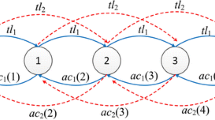Abstract
In this paper, a channel assignment scheme is proposed for use in CDMA/TDMA mobile networks carrying voice and data traffic. In each cell, three types of calls are assumed to compete for access to the limited number of available channels by the cell: new voice calls, handoff voice calls, and data calls. The scheme uses the movable boundary concept in both the code and time domains in order to guarantee the quality of service (QoS) requirements of each type. A traditional Markov analysis method is employed to evaluate the performance of the proposed scheme. Measures, namely, the new call blocking probability, the handoff call forced termination probability, the data call loss probability, the expected number of handoff and the handoff link maintenance probability are obtained from the analysis. The numerical results, which are validated by simulation, indicate that the scheme helps meet the QoS requirements of the different call types.
Similar content being viewed by others
References
Wang J., Zeng Q.-A., Agrawal D. (2003) Performance analysis of a preemptive and priority reservation handoff scheme for integrated service-based wireless mobile networks. IEEE Transactions on Mobile Computing 2(1): 65–75
Chu Y.-K., Wie S.-H., Choi H.-H., Cho D.-H. (2002) Performance analysis of bulk handoff in integrated voice/data wireless networks. IEICE Transaction on Communication E85-B(7): 1396–1401
Li B., Li L., Cao X.-R. (2003) On handoff performance for an integrated voice/data cellular system. Wireless Networks 9: 393–402
Korowajczuk L., Xavier B., Filho A., Ribeiro L., Korowajczuk C., Da Silva L. A. (2004) Designing cdma2000 Systems. Wiley, New York
Holma H., Toskala A. (2004) WCDMA FOR UMTS. Wiley, New York
C.S0024-A, cdma2000 high rate packet data air interface specificatio, Release A, 3GPP2, V 1.0, Mar 2004.
C.S0005-D, Upper layer (Layer 3) signaling standard for cdma2000 spread spectrum systems, Release D, 3GPP2, V 2.0, Feb 2005.
C.S0004-D, Signaling link access control (LAC) standard for CDMA2000 spread spectrum systems, Release D, 3GPP2, V 2.0, Feb 2005.
Lin K.-J., Tseng Y.-C., Sheu J.-P. (2002) Channel-sharing strategies in two-tier cellular PCS systems. Computer Communications 25(14): 1333–1342
Ma M., Gunawan E. (2005) AMAC protocol for multimedia traffic in slotted CDMA wireless communication systems. Wireless Personal Communications 33: 153–176
Li B., Li L., Bo Li, Sivalingam K., Cao X. (2004) Call admission control for voice/data integrated Cellular networks: Performance analysis and comparative study. IEEE Journal on Selected Areas in Communications 22(4): 706–718
Jian L., Gunawan E. (2003) Performance analysis of a modified CDMA/PRMA MAC protocol. Computer Communications 26: 1673–1680
Li X. J., Chong P. H. J. (2008) A dynamic channel assignment scheme for TDMA-based multihop cellular networks. IEEE Transactions on Wireless Communications 7(6): 1999–2003
Wang L., Min G., Kouvatsos D. (2008) Performance analysis of a dynamic handoff scheme in wireless networks with heterogeneous call arrival processes. Telecommunication Systems 39: 157–167
Nassar H., Al-Mahdi H. (2009) Design and analysis of a TDMA call assignment scheme for cellular networks. Computer Communications 32(6): 1200–1206
Nassar H., Al-Mahdi H. (2003) Queueing analysis of an ATM multimedia multiplexer with nonpreemptive priority. IEE Proceedings on Communications 150(3): 189–196
Nassar H., Fouad Y. (2003) Analysis of two-class discrete packet queues with homogenous arrival and prioritized service. Communications in Information and Systems 3(2): 101–117
Javier S., Mamadou T. (2007) UMTS. Wiley, New York
Gilhousen K. S., Jacobs I. M, Viterbi A. J., Weaver J. R., Wheatley C. E. (1991) On the capacity of a cellular CDMA system. IEEE Transactions on Vehicular Technology 40: 303–312
Donald G., Carl H. (2008) Fundamentals of Queueing Theory 3RD Edition. Wiley, New York
Kleinrock L. (1976) Queueing Systems, vol. I. Wiley, New York
Lin Y.-B., Chlamtac I. (1997) A model with generalized holding and cell residence times for evaluating handoff rates and channel occupancy times in PCS networks. International Journal of Wireless Information Networks 4(4): 163–171
Fang Y., Chlamtac I. (1998) Channel occupancy times and handoff rate for mobile computing and PCS networks. IEEE Transactions on Computers 47(6): 679–692
Author information
Authors and Affiliations
Corresponding author
Rights and permissions
About this article
Cite this article
Al-Mahdi, H., Nassar, H., Fouad, Y. et al. Design and Analysis of a Channel Assignment Scheme for CDMA/TDMA Mobile Networks. Wireless Pers Commun 69, 579–599 (2013). https://doi.org/10.1007/s11277-012-0591-9
Published:
Issue Date:
DOI: https://doi.org/10.1007/s11277-012-0591-9




